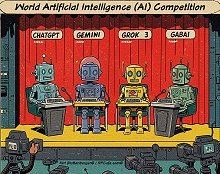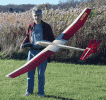Electronics & Technology
- See Full List of AI Topics -

LoRa (Long Range) is a wireless communication technology specifically designed
for long-range, low-power, and low-bandwidth data transmission, making it ideal
for applications in the Internet of Things (IoT). Developed by Semtech, LoRa has
become a cornerstone of Low-Power Wide-Area Networks (LPWANs), addressing the unique
demands of IoT devices that require extended battery life and reliable communication
over long distances. Unlike other wireless standards such as Wi-Fi or Bluetooth,
LoRa prioritizes distance and energy efficiency, enabling devices to transmit small
amounts of data across several kilometers with minimal power consumption.
The development of LoRa traces back to the early 2010s, when a French startup
called Cycleo developed a proprietary modulation scheme known as Chirp Spread Spectrum
(CSS). Semtech acquired Cycleo in 2012, adopting this modulation technique as the
foundation for LoRa. This technology allowed for robust long-range communication
even in environments with significant interference or noise, making it well-suited
for IoT applications like smart cities, agriculture, and industrial monitoring.
LoRa's focus on low-power, long-distance communication provides a solution for scenarios
where sensors need to operate over large geographic areas without frequent battery
replacements.
The IEEE (Institute of Electrical and Electronics Engineers) has played a critical
role in supporting the standardization and promotion of LoRa technology. While LoRa
itself is a proprietary technology owned by Semtech, its integration into global
IoT networks has been advanced by contributions from IEEE working groups and research
initiatives. Specifically, the IEEE 802.15.4 standard, which focuses on low-rate
wireless personal area networks, has provided foundational insights that complement
LoRa's approach to low-power communication. Although LoRa operates outside the formal
IEEE standards, the IEEE's work in spectrum management, interference mitigation,
and network protocols has contributed to LoRa's success in harmonizing with other
wireless communication technologies in the increasingly crowded IoT ecosystem.
One of the most significant IEEE contributions to LoRa has been through its focus
on LPWAN technologies and IoT frameworks. The IEEE Internet of Things Initiative
and various working groups within the IEEE Standards Association have facilitated
discussions, research, and collaborative projects that have shaped how LoRa is deployed
within global IoT architectures. The IEEE's research conferences and technical papers
have provided platforms for developing interoperability strategies between LoRa
and other wireless technologies, ensuring that LoRa can co-exist and complement
more traditional wireless communication systems like Wi-Fi and Zigbee.
LoRa's primary features reflect its emphasis on long-range, low-power transmission.
It operates in unlicensed sub-GHz frequency bands, such as 868 MHz in Europe and
915 MHz in the U.S., enabling widespread use without the need for costly spectrum
licenses. With a range that can extend up to 15 kilometers in rural environments
and several kilometers in urban settings, LoRa is particularly well-suited for IoT
deployments that require connectivity over large areas, such as agricultural monitoring,
smart cities, and industrial automation. Its power efficiency is another standout
feature, enabling devices to function on battery power for up to 10 years, drastically
reducing the need for maintenance. The IEEE's ongoing work on radio spectrum utilization
and IoT network efficiency has helped guide LoRa's integration into broader smart
city and industrial networks.
The robustness of LoRa's communication, particularly its ability to penetrate
through physical obstacles like walls and foliage, is one of its key strengths.
This makes it highly valuable in industrial environments and remote areas where
wireless infrastructure is sparse. LoRa's scalability allows for networks that can
support millions of connected devices, a feature essential for IoT's growth. LoRaWAN,
the protocol that runs on top of LoRa's physical layer, provides the networking
and security features needed for large-scale deployments. LoRaWAN enables bi-directional
communication, multiple data rates, and dynamic power adjustments based on distance
from the gateway, further optimizing the power efficiency of devices.
Despite these strengths, LoRa does have its limitations. Its data rates, which
range from 0.3 kbps to 50 kbps, are significantly lower than other wireless standards,
making it unsuitable for applications that require high-bandwidth communication,
such as video streaming or real-time analytics. Moreover, LoRa's operation in unlicensed
spectrum can lead to interference in environments where many devices are competing
for the same frequencies. The IEEE's work on coexistence strategies and spectrum
sharing has been instrumental in addressing some of these challenges by developing
techniques to reduce interference and ensure smooth operation of LoRa networks in
dense environments.
LoRa's deployment has been rapid, with applications ranging from smart cities
and utilities to agriculture and industrial IoT. Smart city deployments have leveraged
LoRa for applications such as traffic management, environmental monitoring, and
public safety systems, while in agriculture, LoRa enables precision farming by connecting
sensors that monitor soil moisture, crop health, and weather conditions. The IEEE's
research and involvement in smart city frameworks have helped guide LoRa's adoption
in these areas, particularly in creating interoperable networks that can accommodate
a wide variety of sensors and data sources.
The development timeline for LoRa began with Semtech's acquisition of Cycleo
in 2012 and the release of the first LoRa chips in 2013. The technology gained momentum
with the formation of the LoRa Alliance in 2015, a non-profit association that includes
key industry players like Cisco, IBM, and Orange, alongside hundreds of other companies.
The IEEE's support of LPWAN technologies, through its conferences and publications,
has helped solidify LoRa's place within the global IoT landscape. By 2021, LoRa
had become one of the dominant technologies in the LPWAN space, with millions of
devices connected globally and growing support from both the public and private
sectors.
Key individuals who have been instrumental in LoRa's development include Nicolas
Sornin, who led the development of LoRa's modulation technique, and Mohan Maheswaran,
CEO of Semtech, who has overseen the commercialization of LoRa technology. The LoRa
Alliance has been led by industry figures such as Donna Moore, who has been instrumental
in promoting LoRaWAN as an open standard for IoT deployments. The IEEE's involvement,
though not directly tied to these individuals, has been crucial in providing the
technical foundation for LoRa's interaction with other wireless standards.
Academic institutions and government agencies have also contributed to the research
and development of LoRa. Universities such as Stanford and MIT, whose researchers
are often affiliated with the IEEE, have explored the potential of LPWAN technologies
like LoRa for large-scale sensor networks and smart infrastructure. Government-funded
projects, particularly in Europe and the U.S., have supported LoRa's deployment
in various public-sector initiatives, such as environmental monitoring and disaster
response systems. The IEEE's focus on IoT research, particularly in areas like sensor
networks and low-power communication, has provided the academic and technological
foundation for many of these projects.
In conclusion, LoRa is a key technology driving the expansion of IoT networks
worldwide, offering long-range, low-power communication that is well-suited for
a variety of applications. The IEEE has played an essential role in supporting LoRa's
growth, from research and standardization efforts to facilitating industry collaboration
and addressing technical challenges like spectrum sharing and interference management.
As LoRa continues to evolve, with strong backing from the LoRa Alliance and contributions
from the IEEE, it is poised to remain a critical technology for the future of IoT
and smart infrastructure, helping to enable a world where billions of devices can
connect and communicate efficiently over vast distances.
 This content was generated by primarily
the ChatGPT (OpenAI), and/or
Gemini (Google), and/or
Arya (GabAI), and/or
Grok (x.AI), and/or DeepSeek artificial intelligence (AI) engine.
Some review was performed to help detect and correct any inaccuracies; however,
you are encouraged to verify the information yourself if it will be used for critical
applications. In some cases, multiple solicitations to the AI engine(s) was(were) used to assimilate
final content. Images and external hyperlinks have also been added occasionally.
Courts have ruled that AI-generated content is not subject to copyright restrictions,
but since I modify them, everything here is protected by RF Cafe copyright. Many
of the images are likewise generated and modified. Your use of this data implies
an agreement to hold totally harmless Kirt Blattenberger, RF Cafe, and any and all
of its assigns. Thank you. Here are the major categories. This content was generated by primarily
the ChatGPT (OpenAI), and/or
Gemini (Google), and/or
Arya (GabAI), and/or
Grok (x.AI), and/or DeepSeek artificial intelligence (AI) engine.
Some review was performed to help detect and correct any inaccuracies; however,
you are encouraged to verify the information yourself if it will be used for critical
applications. In some cases, multiple solicitations to the AI engine(s) was(were) used to assimilate
final content. Images and external hyperlinks have also been added occasionally.
Courts have ruled that AI-generated content is not subject to copyright restrictions,
but since I modify them, everything here is protected by RF Cafe copyright. Many
of the images are likewise generated and modified. Your use of this data implies
an agreement to hold totally harmless Kirt Blattenberger, RF Cafe, and any and all
of its assigns. Thank you. Here are the major categories.
Electronics & High Tech
Companies | Electronics &
Tech Publications | Electronics &
Tech Pioneers | Electronics &
Tech Principles |
Tech Standards Groups &
Industry Associations | Societal
Influences on Technology
|








